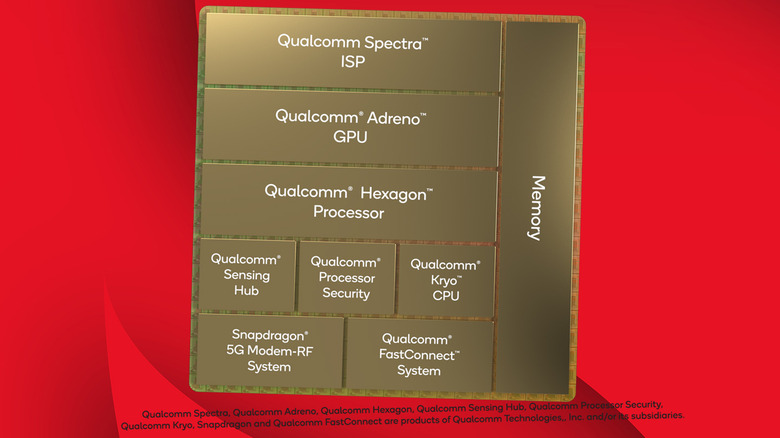Snapdragon 8 Gen 1 revealed: The details that matter to your next phone
Today we're taking a peek at the newly-revealed Snapdragon 8 Gen 1 Mobile Platform from Qualcomm. This next-generation tech will be delivered to smart devices in the very near future – for now, we're exploring what Qualcomm revealed to us about their next Mobile Platform for the most powerful smartphones (and related smart devices) in the world. Today we've got a list of the details that'll matter to you, the end user.
5. A few basic bits
Qualcomm's Snapdragon 8 Gen 1 Mobile Platform works with 4nm Process Technology and support for 4K resolution with 60 Hz (60 frames per second image refresh rate), or QHD+ resolution with 144 Hz support. We're looking at up to 3.0 GHz Kryo CPU support with Arm Cortex-X2 technology (64-bit).
If you see a device with a set of specifications that includes the part number SM8450, you're looking at a device with a Snapdragon 8 Gen 1 system onboard. You'll be rolling with the 7th Gen Qualcomm AI Engine with support for Leica's Leitz Look mode, Hugging Face (notifications), and voice analysis from Sonde Health.
4. Audio connectivity
With the Snapdragon 8 Gen 1, Qualcomm incorporated the first Bluetooth LE Audio features like voice back-channel for gaming, stereo recording, and broadcast audio. Snapdragon Sound Technology is included with dual Bluetooth antennas, Bluetooth 5.2, and aptX Adaptive support.
Qualcomm Aqstic audio codec is in play, with a new Qualcomm Aqstic smart speaker amplifier, the latest Qualcomm Audio and Voice Communication Suite, and Total Harmonic Distortion + Noise (THD+N) and -108dB playback.
3. Gaming power
Audio features continue with Audiokinetic technology for gaming – with what Qualcomm calls "immersive, console-quality sound." This is the first platform Qualcomm's released with Audiokinetic technology in the mix.
As is generally the case, this latest platform improves upon the graphics processing power of its predecessor by a significant margin. Qualcomm suggests that the Snapdragon 8 Gen 1's own Adreno GPU in this generation is 30% faster graphics rendering than the Snapdragon 888. Power efficiency is also better with this generation than the Snapdragon 888, by a whopping 25%.
Snapdragon 8 Gen 1 works with Vulkan 1.1, OpenCL 2.0 FP, and OpenGL ES 3.2 API support, HDR gaming, Adreno Frame Motion Engine, volumetric rendering and physically based rendering. Qualcomm goes so far as to call out support for Unreal Engine 5 from Epic Games – with all the bells and whistles such specific support provides.
2. Camera power
Snapdragon Sight Technology was introduced with Snapdragon 8 Gen 1. This tech allows your phone to work with Qualcomm's first-ever 18-bit ISP (image signal processor), a significant jump over the otherwise most recent solution (14-bit). This advanced image processor tech has the power to support 8K HDR video capture and image capture speeds up to 3.2 gigapixels per second.
As it has been with previous solutions from Qualcomm, the power of your device's camera setup depends on a combination of elements. Qualcomm itself cannot deliver all the camera power you need – you'll need a high-end hardware setup that utilizes the Qualcomm image processing tech to the fullest.
The good news there is that the brightest brands generally take full advantage of the camera tech incorporated in the latest Qualcomm chipset. We have only to wait and see which companies incorporate this tech in their next smartphone to see if Qualcomm's claims are fulfilled to the max.
1. 5G upgrades
In the next couple of years, you'll almost certainly have a 5G-capable smartphone and 5G connectivity basically anywhere you might roam. With the Snapdragon 8 Gen 1 series you'll find support for the 4th Gen Snapdragon X65 5G Modem-RF System. This system includes three "world's first" features.
This is the world's first 10-Gigabit 5G Modem-RF solution. It's also the world's first 5G uplink carrier aggregation – that's multiple frequency bands used together – for potentially faster upload speeds on mobile devices than we've ever seen before.
This system also delivers the world's first 3GPP Release 16 5G solution. This should drastically improve reliability of mobile connectivity with 5G. This tech might be ready to roll even before you're ready to connect – the Snapdragon 8 Gen 1 series is expected to be released in smartphones starting in the first quarter of the year 2022!
And one for businesses
Qualcomm also announced a collaboration with Google Cloud on Neural Architecture Search (NAS). This technology will be available on Snapdragon 8, Gen 1 Mobile Platform first, then across Qualcomm Technologies portfolio on into the future. With this tech, companies will be able to both create and optimize artificial intelligence (AI) models automatically (rather than manually).
Google Cloud Vertex AI NAS will work with Qualcomm Technologies SoC products to accelerate development for a variety of platforms. Qualcomm Technologies platforms that'll benefit from this collaboration include automotive, mobile, ACPC, XR, and IoT.

